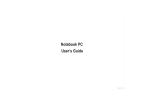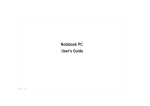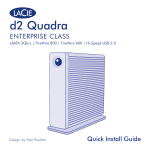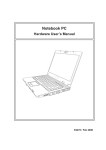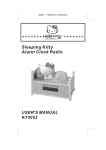Download USER MANUAL FOR EMPRESS NB
Transcript
Notebook PC
User’s Guide
NB-EMPRESS
Notational Conventions
Throughout this manual, the following conventions are used to distinguish elements of text.
Note:
identifies additional information that requires special attention.
Warning :
identifies additional information that requires special attention.
Tip :
identifies additional information that requires special attention.
Caution:
identifies important information that, if not followed,
may result in loss of data or damage to the computer.
Keyboard keys are shown in a bold typeset. For example:
Press Enter to complete.
When keys are joined by a plus sign (+), press the first key, and, while keeping the first key down, press the
remaining keys, finally release all the keys. When necessary, keys are also shown in graphics.
A title, command, setup item, or button that you can see on the screen is shown in boldface.
Overview
Chapter - 1
Introducing the Notebook PC
1-1
Chapter - 2
Knowing the Parts
2-1
Chapter - 3
Getting Started
3-1
Chapter - 4
Using the Notebook PC
4-1
TAKING CARE OF YOUR NOTEBOOK PC
To prevent possible overheating of the computer's
processor, make sure you don't block the openings
provided for ventilation.
DO NOT press or touch the display panel.
DO NOT place or drop objects on the computer
and DO NOT apply heavy pressure on it.
DO NOT subject the computer to magnetic
fields.
DO NOT place on uneven or unstable work
surfaces.
DO NOT use your notebook computer under
harsh conditions.
DO NOT expose to direct sunlight.
DO NOT use or store in extreme
temperatures.
Avoid sudden changes in temperature or humidity
by keeping it away from A/C and heating vents.
DO NOT expose to dust and/or corrosive
chemicals.
DO NOT expose the computer to rain or
moisture.
DO NOT slam your notebook shut and never
pick up or hold your notebook by the display.
DO NOT place near fire or other sources of heat.
DO NOT spray water or any other cleaning fluids
directly on the display.
DO NOT tamper with the batteries. Keep them
away from children.
If you are traveling with your computer,
remember to carry it as hand luggage. Do not
check it in as baggage.
User's Guide
Introducing the Notebook PC
Chapter - 1
Introducing the Notebook PC
Transportation Precautions
To prepare the Notebook PC for transport, you should turn it OFF and disconnect
all external peripherals to prevent damage to the connectors. The hard disk drive's
head retracts when the power is turned OFF to prevent scratching of the hard disk
surface during transport. Therefore, you should not transport the Notebook PC
while the power is still ON. Close the display panel and check that it is latched
securely in the closed position to protect the keyboard and a display panel.
Cover Your Notebook PC
You can purchase an optional carrying case to protect it from dirt, water, shock, and scratches.
Note :
The surface glaze is easily dulled if not properly cared for. Be careful not to rub or scrap the Notebook PC surfaces when
transporting your Notebook PC.
Cover Your Batteries
If you intend to use battery power, be sure to fully charge your battery pack and any optional battery packs
before going on long trips. Remember that the power adapter charges the battery pack as long as it is plugged
into the computer and an AC power source. Be aware that it takes much longer to charge the battery pack when
the Notebook PC is in use.
1-1
User's Guide
Introducing the Notebook PC
Airplane Precautions
Contact your airline if you want to use the Notebook PC on the airplane. Most airlines will have restrictions for
using electronic devices. Most airlines will allow electronic use only between and not during takeoffs and
landings.
Caution :
There are three main types of airport security devices: X-ray machines (used on items placed on conveyor belts), magnetic
detectors (used on people walking through security checks), and magnetic wands (hand-held devices used on people or
individual items). You can send your Notebook PC and diskettes through airport X-ray machines. However, it is
recommended that you do not send your Notebook PC or diskettes through airport magnetic detectors or expose them to
magnetic wands.
1-2
User's Guide
Introducing the Notebook PC
Preparing your Notebook PC
These are only quick instructions for using your Notebook PC. Read the later pages for detailed information on
using your notebook PC.
1. Install the battery pack
3. Open the Display Panel
2. Connect the AC Power Adapter
4. Turn ON the Notebook PC
Important :
When opening, do not force the display panel down to the table or else the hinges may break! Never lift the notebook PC by
the display panel!
1-3
User's Guide
Knowing the Parts
Chapter - 2
Basic sides of the Notebook PC
Knowing the Parts
Top Side
Refer to the diagram to identify the components on
this side of the Notebook PC.
2-1
User's Guide
Knowing
theyou
Parts
Before
Start
u Camera (on selected models)
The built-in camera allows picture taking or video recording. Can be used with video conferencing and other
interactive applications.
v Microphone (Built-in)
The built-in mono microphone can be used for video conferencing, voice narrations, or simple audio
recordings.
w Display Panel
The display panel functions the same as a desktop monitor. The Notebook PC uses an active matrix TFT LCD,
which provides excellent viewing like that of desktop monitors. Unlike desktop
monitors, the LCD panel does not produce any radiation or flickering, so it is easier on
the eyes, Use a soft cloth without chemical liquids (use plain water if necessary) to
clean the display panel.
x Power Switch
The power switch allows powering ON and OFF the Notebook PC and recovering from
Standby. Use the switch once to turn ON and once to turn OFF the Notebook PC. In
windows Vista, this button can also be used to safely turn OFF the Notebook PC. The
power switch only works when the display panel is opened.
2-2
User's Guide
Knowing the Parts
y Instant Keys
Instant keys allow you to launch frequently used applications with one push of a button. Details are described in
chapter- 3.
z Keyboard
The keyboard provides full-sized keys with comfortable travel (depth at which the keys can be depressed) the
palm rest for both hands. Two Windows function keys are provided to help ease navigation in the windows™
operating system.
{ Touchpad and Buttons
The touchpad with its buttons is a pointing device that provides the same functions as a desktop mouse. A
software-controlled scrolling function is available after setting up the included touchpad utility to allow easy
Windows or web navigation.
| Status Indicators (front)
Status indicators represent various hardware/software conditions. Details are described in Chapter - 3.
} Status indicators (top)
Status indicators represent various hardware/software conditions. Details are described in Chapter - 3.
2-3
User's Guide
Knowing the Parts
Bottom Side
Refer to the diagram below to identify the components on this side of the Notebook PC.
7
Warning :
The bottom of the Notebook PC can get very hot. Be careful when handling the Notebook PC while it is in operation or
recently been in operation. High temperatures are normal during charging or operation. Do not use on soft surfaces such as
beds or sofas which may block the vents. DO NOT PUT THE NOTEBOOK PC ON YOUR LAP OR OTHER PARTS
OF THE BODY TO AVOID INJURY FROM THE HEAT.
2-4
User's Guide
17
Knowing the Parts
Central Processor Unit (CPU)
This Notebook PC features a socketed-processor design to allow upgrading to faster processors in the future.
Visit HCL authorized service center for information on upgrades.
Warning :
End-user removal of the CPU or hard disk drive will void the warranty.
27
Memory (RAM) Compartment
The memory compartment provides expansion capabilities for additional memory. Additional memory will
increase application performance by decreasing hard disk access. The BIOS automatically detects the amount
of memory in the system and configures CMOS accordingly during the POST (Power-On-Self-Test) Process.
There is no hardware or software (including BIOS) setup required after the memory installation. Visit an
authorized service center for information on memory upgrades for your Notebook PC.
37
Hard disk drive Compartment.
The hard disc drive is secured in a compartment. Hard disk drive upgrades are to be done by HCL authorized
service centers only.
47
Audio Speakers
The built-in stereo speaker system allows you to hear audio without additional attachments. The multimedia
sound system features an integrated digital audio controller that produces rich, vibrant sound (results improved
with external stereo headphones or speakers). Audio features are software controlled.
2-5
User's Guide
57
Knowing the Parts
Battery Pack
The battery pack is automatically charged when connected to an AC power source and maintains power to the
Notebook PC when AC power is not connected. This allows us moving temporarily between locations. Battery
time varies by usage and by the specifications for this Notebook PC. The battery pack cannot be disassembled
and must be replaced as a single unit through HCL authorized dealer.
67
Wireless LAN(WLAN) Compartment (Selected models only)
The WLAN compartment allows the installation of a wireless networking card in order to wirelessly connect to
network access points or other wireless networking devices.
77
Internal Mini PCI Express Slot (Selected models only)
This internal Mini PCI express slot allows to install Intel® Turbo memory module.
2-6
User's Guide
Knowing the Parts
Right Side
Refer to the diagram below to identify the components on this side of the Notebook PC.
1
Headphone Output Jack
The stereo headphone jack (1/8inch ) is used to connect the Notebook PC’s audio out signal to amplified
speakers or headphones. Using this jack automatically disables the built-in speakers.
2
Microphone Input Jack
The mono microphone jack (1/8inch) can be used to connect an external microphone. Using this jack
automatically disables the built-in microphone. Use this feature for video conferencing, voice narrations, or
simple audio recordings.
3
USB Port (2.0/1.1)
The Universal Serial Bus is compatible with USB 2.0 or USB 1.1 devices such as keyboards, pointing devices,
cameras, hard disk drives, printers, and scanners connected in a series up to 12Mbits/sec
(USB 1.1) and 480Mbit/sec (USB 2.0). USB allows many devices to run simultaneously on a
single computer, with peripherals such as USB keyboards and some newer monitors acting
as additional plug-in sites or hubs. USB supports hot-swapping of devices so that most
peripherals can be connected or disconnected without restarting the computer.
2-7
User's Guide
4
Knowing the Parts
IEEE 1394 Port
IEEE1394 is a high speed serial bus like SCSI but has simple connections and hotplugging capabilities like USB. The interface IEEE1394 has a bandwidth of 100-400
Mbits/sec can handle up to 63 units on the same bus. IEEE1394 is also used in high-end
digital equipment and should be marked "DV" for Digital Video port.
5
ExpressCard Slot
One 26pin Express card slot is available to support one ExpressCard/34mm or one ExpressCard/54mm
expansion card. This new interface is faster by using a serial bus supporting USB 2.0 and PCI Express instead
of the slower parallel bus used in the PC card slot. (Not compatible with previous PCMCIA cards.)
6
Flash Memory Slot
This Notebook PC has a built-in memory card reader that can read many flash memory cards as specified in.
The built -in memory card reader is not only convenient, but also faster than most other forms of memory card
readers because it utilizes the high bandwidth PCI bus.
2-8
User's Guide
Knowing the Parts
Left Side
Refer to the diagram below to identify the components on this side of the Notebook PC.
1
Optical Drive(Type of optical drive depends upon your ordering)
The Notebook PC's optical drive may support compact discs (CD) and/or digital video discs
(DVD) and have recordable (R) or re-writable (RW) capabilities.
2
Optical Drive Activity Indicator
The optical drive activity indicator shows when data is being transferred by the optical disk drive. This indicator
will light in proportion to the data size transferred.
3
Optical Drive Electronic eject
The optical drive eject has an electronic eject button for opening the tray. You can also eject the
optical drive tray through any software player or by right clicking the optical drive in WindowsTM "My
Computer” and selecting eject.
2-9
User's Guide
4
Knowing the Parts
Optical Drive Emergency Eject.
The emergency eject is used to eject the optical drive tray in case the electronic eject does
not work. Do not use the emergency eject in place of the electronic eject.
Front Side
Refer to the diagram below to identify the components on this side of the Notebook PC.
2-10
User's Guide
1
Knowing the Parts
Audio Speakers
The built-in stereo speaker system allows you to hear audio without additional attachments. The multimedia
sound system features an integrated digital audio controller that produces rich, vibrant sound (results improved
with external stereo headphones or speakers). Audio features are software controlled.
2
CIR (Consumer Infrared) Port (on selected models)
The consumer infrared communication port allows convenient wireless control of the provided multimedia
software in selected models using the provided wireless remote control in selected models.
3
Display Panel Latch
One spring-loaded latch on the front of the Notebook PC locks the display panel in the closed position when the
Notebook PC is not in use. To open the display panel,move the latch with your thumb and lift up the display
panel while holding the latch.Slowly tilt the display panel forward or backward to a comfortable viewing angle.
Warning :
When opening ,do not force the display panel down to the table or else the hinges may break! Never lift the Notebook PC by
the display panel!
2-11
User's Guide
Knowing the Parts
Rear Side
Refer to the diagram below to identify the components on this side of the Notebook PC.
1
USB Port(2.0/1.1)
The Universal Serial Bus is compatible with USB 2.0 or USB 1.1 devices such as keyboards, pointing devices,
cameras, hard disk drives, printers and scanners connected in a series up to 12Mbits/sec (USB 1.1) and
480Mbit/sec (USB 2.0). USB allows many devices to run simultaneously on a single computer, with peripherals
such as USB keyboards and some newer monitors acting as additional plug-in sites or hubs. USB supports hotswapping of devices so that most peripherals can be connected or disconnected without restarting the
computer.
2
Display(Monitor) output
The 15-pin D-sub monitor port supports a standard VGA-compatible device such as a monitor or projector to
allow viewing on a larger external display.
2-12
User's Guide
3
Knowing the Parts
LAN Port
The RJ-45 LAN port with eight pins is larger than the RJ-11 Modem port and supports a standard Ethernet
cable for connection to a local network. The built-in connector allows convenient use without additional
adapters.
4
Modem Port
The RJ-11 modem port is smaller than the RJ-45 LAN port and supports a standard telephone cable. The
internal modem supports up to 56Kbps transfers. The built-in connector allows convenient use without
additional adapters.
IMPORTANT!
The built-in modem does not support the voltage used in digital phone systems. Do not connect the modem port to a
digital phone system or else damage will occur to the Notebook PC.
55
Antenna Input (on selected models)
The antenna input is for TV or FM Radio (on selected models) frequency signal and allows for use with the
provided digital TV/FM antenna or input from subscription television services. The provided antenna can
receive digital TV or FM radio. Cable service connection can receive digital TV, analog TV, or FM radio
depending on paid services. Note: Use the provided adapter for use with coaxial connectors.
6
Power (DC) Input
The supplied power adapter converts AC power to DC power for use with this jack. Power supplied through this
jack supplies power to the Notebook PC and charges the internal battery pack. To prevent damage to the
Notebook PC and battery pack, always use the supplied power adapter. CAUTION: MAY BECOME WARM TO
HOT WHEN IN USE. BE SURE NOT TO COVER THE ADAPTER AND KEEP IT AWAY FROM YOUR BODY.
2-13
User's Guide
77
Knowing the Parts
Kensington® Lock Port
The Kensington® lock port allows the Notebook PC to be secured using Kensington® compatible Notebook
PC security products. These security products usually include a metal cable and lock that prevent the
Notebook PC to be removed from a fixed object. Some may also include a motion detector to sound an alarm
when moved.
87
Air Vents
The air vents allow cool air to enter and warm air to exit the Notebook PC.
Important :
Make sure that paper,books,clothing,cables or other objects do not block any of the air vents or else overheating of the
Notebook PC may occur.
2-14
User's Guide
Getting Started
Chapter - 3
Getting Started
Power System
Using AC Power
The Notebook PC power is comprised of two parts, the power adapter and
the battery power system. The power adapter converts AC power from a
wall outlet to the DC power required by the Notebook PC. Your Notebook
PC comes with a universal AC-DC adapter. That means that you may
connect the power cord to any 100V-120V as well as 220V-240V outlets
without setting switches or using power converters. Different countries
may require that an adapter be used to connect the provided Indianstandard AC power cord to a different standard. Most hotels will provide
universal outlets to support different power cords as well as voltages. It is always best to ask an experienced
traveller about AC outlet voltages when bringing power adapters to another country.
With the AC power cord connected to the AC-DC adapter, connect the AC power cord to an AC outlet
(preferably with surge-protection) and then connect the DC plug to the Notebook PC. Connecting the AC-DC
adapter to the AC outlet first allows you to test the AC outlet's power and the AC-DC converter itself for
compatibility problems before connecting the DC power to the Notebook PC. The power LED on the adapter
lights up if the power is within accepted ranges.
3-1
User's Guide
Getting Started
Important :
Damage may occur if you use a different adapter to power the Notebook PC or use the Notebook PC's adapter to power
other electrical devices. If there is smoke, burning scent, or extreme heat coming from the AC-DC adapter, seek
servicing. You may damage both your battery pack and the Notebook PC with a faulty AC-DC adapter.
Note:
This Notebook PC may come with a three-prong plug. You must use a grounded AC outlet to ensure safe operation of
the Notebook PC.
Warning:
The power adapter may become warm to hot when in use, be sure not to cover the adapter and keep it away from your
body.
Using Battery Power
The Notebook PC is designed to work with a removable battery pack. The battery pack consists of a set of
battery cells housed together. A fully charged pack will provide few hours of battery life, which can be further
extended by using power management features through the BIOS setup.
3-2
User's Guide
Getting Started
Installing and Removing the battery Pack
Your Notebook PC may or may not have its battery pack installed. If your Notebook PC does not have its battery
pack installed, use the following procedures to install the battery pack.
Important :
Never attempt to remove the battery pack while the Notebook PC is turned ON, as this may result in the loss of working
data.
To Install the battery Pack :
To remove the battery pack :
Important :
Only use battery packs and power adapters supplied with the Notebook PC or specifically approved by the manufacturer
for use with this model or else damage may occur to the Notebook PC.
3-3
User's Guide
Getting Started
Battery Care
The Notebook PC's battery pack, like all rechargeable batteries, has a limit on the number of times it can be
recharged. Fully draining and charging the battery once a day every day will last over a year but how long beyond that
will depend on your environment temperature, humidity, and how your Notebook PC is used. It is ideal that the
batteries be used in a temperature range between 10°C and 29°C (50°F and 85°F). You must also take into account
that the Notebook PC's internal temperature is higher than the outside temperature. Any temperatures above or
below this range will shorten the life of the battery. But in any case, the battery pack's usage time will eventually
decrease and a new battery pack must be purchased for this Notebook PC. Because batteries also have a shelf life. it
is not recommended to buy extras for storing.
Warning!
For safety reasons, DO NOT throw the battery in fire, DO NOT short circuit the contacts, and DO NOT disassemble the battery. If
there is any abnormal operation or damage to the battery pack caused by impact, turn OFF the Notebook PC and contact an
authorised service center
Powering ON the Notebook PC
The Notebook PC's power-ON message appears on the screen when you turn it ON. If necessary, you may adjust the
brightness by using the functional keys. If you need to run the BIOS Setup to set or modify the system configuration,
press (F2) upon boot up to enter the BIOS Setup. If you press (Tab) during the splash screen. standard boot
information such as the BIOS version can be seen. Press (ESC) and you will be presented with a boot menu with
selections to boot from your available drive.
Important :
To protect the hard disk drive, always wait at least 5 seconds after turning OFF your Notebook PC before turning it back ON.
Note :
Before bootup, the display panel flashes when the power is turned ON. This is part of the Notebook PC's test routine and is not a
problem with the display.
3-4
User's Guide
Getting Started
The Power - On Self Test (POST)
When you turn ON the Notebook PC, it will first run through a series of software-controlled diagnostic tests called
the Power-On Self Test (POST).The software that controls the POST is installed as a permanent part of the
Notebook PC's architecture. The POST includes a record of the Notebook PC's hardware configuration, which is
used to make a diagnostic check of the system. This record is created by using BIOS Setup program. If the POST
discovers a difference between the record and the existing hardware, it will display a message on the screen
prompting you to correct the conflict by running BIOS Setup. In most cases the record should be correct when you
receive the Notebook PC. When the test is finished, you may get a message reporting "No operating system found "
if the hard disk was not preloaded with an operating system. This indicates that the hard disk is correctly detected
and ready for the installation of a new operating system.
Important :
If warnings are still given during bootup after running a software disk checking utility, you should take your Notebook PC
in for servicing. Continued use may result in data loss.
3-5
User's Guide
Getting Started
Checking Battery Power
The battery system implements the Smart Battery standard under
the Windows environment, which allows the battery to accurately
report the amount of charge left in the battery. A fully-charged
battery pack provides the Notebook PC a few hours of working
power. But the actual figure varies depending on how you use the
power saving features, your general work habits, the CPU and
system memory size.
To check the remaining battery power, move your cursor over the
power icon. The power icon is a " battery" when not using AC power
and a "plug" when using AC power. Double click on the icon for
more information and settings.
Note:
If you ignore the low battery warning, eventually the Notebook PC enters suspend mode (Windows default uses STR)
Warning :
Suspend-to-RAM (STR) does not last long when the battery power is depleted. Suspend-to-Disk (STD) is not the same
as power OFF. STD requires a small amount of power and will fail if no power is available due to complete battery
depletion or no power supply (e.g., removing both the power adapter and battery pack).
Remaining Battery power may be shown in terms of percentage or hours, and these units may vary depending upon the
operating system versions or hardware configuration.
3-6
User's Guide
Getting Started
Charging the Battery Pack
Before you use your Notebook PC you will have to charge the battery pack. The battery pack begins to charge
as soon as the Notebook PC is connected to external power using the power adapter. Fully charge the battery
pack before using it for the first time. A new battery pack must completely charge before the Notebook PC is
disconnected from external power. It takes a few hours to fully charge the battery when the Notebook PC is
turned OFF and may take twice the time when the Notebook PC is turned on. The battery charge light turns
OFF when the battery pack is charged.
Note:
The battery stops charging if the temperature is too high or the battery voltage is too high.
Power Options
The power switch turns ON and OFF the Notebook PC or putting the Notebook PC into sleep or hiberna-tion
modes. Actual behavior of the power switch can be customized in Windows Control Panel "Power Options.”
For other options, such as "Switch User, Restart, Sleep, or Shut Down," click the arrowhead next to the lock
icon.
Restarting or Rebooting
After making changes to your operating system, you may be prompted to
restart the system. Some installation processes will provide a dialog box to
allow restart. To restart the system manually, click Windows Start button
and select “Turn OFF computer” and then choose Restart.
Powering Off
In Windows Vista, power OFF the Notebook PC by clicking Windows Start
button and select “Turn OFF” and then choose Turn OFF (or Shut Down).
3-7
User's Guide
Getting Started
Important :
To protect the hard drive, wait at least 5 seconds after turning OFF your Notebook PC before turning it back ON.
Emergency Shutdown
In case your operating system cannot properly turn OFF or restart, there are two additional ways to shutdown
your Notebook PC:
(1) Hold the power button
over 4 seconds
TIP: Use a straightened paper clip to press the shutdown button.
Important :
Do not use emergency shutdown while data is being written; doing so can result in loss or destruction of your data.
3-8
User's Guide
Power Management Modes
The Notebook PC has a number of automatic or adjustable power saving features that you can use to
maximize battery life and lower Total Cost of Ownership (TCO). You can control some of these features through
the Power menu in the BIOS Setup. ACPI power management settings are made through the operating
system. The power management features are designed to save as much electricity as possible by putting
components into a low power consumption mode as often as possible but also allow full operation on demand.
Sleep and Hibernate
Power management settings can be found in the Windows > Control Panel >
Power Options. In System Settings, you can define "Sleep/Hibernate" or "Shut
Down" for closing the display panel or pressing the power button. "Sleep" and
"Hibernate" saves power when your Notebook PC is not in use by turning OFF
certain components. When you resume your work, your last status (such as a
document scrolled down half way or email typed half way) will reappear as if you
never left. "Shut Down" will close all applications and ask if you want to save your
work if any are not saved.
Sleep is the same as Suspend-to-RAM (STR). This function stores your current
data and status in RAM while many components are turned OFF. Because RAM
is volatile, it requires power to keep (refresh) the data. Click the Start button and
the arrowhead next to the lock icon to see this option. You can also use the
keyboard shortcut [Fn F1] to activate this mode. Recover by pressing any
keyboard key except [Fn]. (NOTE: The power indicator will blink in this mode.)
3-9
User's Guide
Hibernate is the same as Suspend-to-Disk (STD) and stores your current data and status on the hard disk
drive. By doing this, RAM does not have to be periodically refreshed and power consumption is greatly reduced
but not completely eliminated because certain wake-up components like LAN needs to remain powered.
"Hibernate" saves more power compared to "Sleep". Click the Start button and the arrowhead next to the lock
icon to see this option. Recover by pressing the power button. (NOTE: The power indicator will be OFF in this
mode.)
Thermal Power Control
There are three power control methods for controlling the Notebook PC's thermal state. These power control
cannot be configured by the user and should be known in case the Notebook PC should enter these states. The
following temperatures represent the chassis temperature (not CPU).
• The fan turns ON for active cooling when the temperature reaches the safe upper limit.
• The CPU decreases speed for passive cooling when the temperature exceeds the safe upper limit.
• The system shut down for critical cooling when temperature exceeds the maximum safe upper limit.
3-10
User's Guide
Getting Started
Special Keyboard Functions
Colored Hot keys
The following define the colored hot keys on the Notebook PC's keyboard. The colored commands can only be
accessed by first pressing and holding the function key while pressing a key with a colored command.
Note:
The Hot Key locations on the function keys may vary depending on model but the functions should remain the same.
Follow the icons instead of the function keys.
"Zz" Icon (F1) : Places the Notebook PC in suspend mode (either Save-to-RAM or Save-to
Disk depending on sleep button setting in power management setup).
Radio Tower (F2): Toggles the internal wireless LAN or Bluetooth (on selected models) ON
or OFF with and on-screen-display. When enabled, the corresponding wireless indicator
will light. Windows software settings are necessary to use the wireless LAN or Bluetooth.
Filled Sun Icon (F5) :
Decreases the display brightness
Open Sun Icon (F6)
Increases the display brightness
LCD Icon (F7) : Toggles the display panel ON and OFF.
3-11
User's Guide
Getting Started
LCD/ Monitor Icon (F8): Toggles between the Notebook PC's LCD display and an external
monitor in this series: Notebook PC LCD->External Monitor-> Both. (This function does not work in
256 Colors, select High Color in Display property Settings.) IMPORTANT : Connect an external
monitor before booting up the Notebook Pc.
Speaker Icons (F10):
Toggles the speakers ON and OFF (only in Window OS).
Speaker Down Icons (F11):
Decreases the speaker volume (only in Window OS).
Speaker Up Icons (F12):
Increases the speaker volume (only in Window OS).
Num Lk (Ins) : Toggles the numeric keypad (number lock) ON and OFF. Allows you to
use a larger portion of the keyboard for number entering.
Scr Lk (Del): Toggles the "Scroll Lock" ON and OFF. Allows you to use a larger portion
of the keyboard for cell navigation.
Microsoft Window Keys
There are two special Windows keys on the keyboard as described below :
The key with the Windows logo activates the Start menu located at the bottom left of the
Windows desktop.
The other key, that looks like a Windows menu with a small cursor, activates the properties
menu and is equivalent to pressing the right mouse button on a Windows object.
3-12
User's Guide
Getting Started
Keyboard as a Numeric Keypad
The numeric keypad is embedded in the keyboard and consists of 15
Keys that make number intensive input more convenient. These
dual-purpose keys are labeled in Blue on the key caps. Numeric
assignments are located at the upper right hand corner of each key
as shown in the figure. When the numeric keypad is engaged by
pressing (Fn)(Ins/Num LK), the number lock LED lights up. If an
external keyboard is connected, pressing the (Ins/Num LK) on the
external keyboard enables/disable the NumLock on both keyboard
simultaneously. To disable the numeric keypad while keeping the
keypad on an external keyboard activated, press the (Fn)(Ins/Num LK) keys on the Notebook PC.
Keyboard as Cursors
The keyboard can be used as cursors while Number Lock is ON or
OFF in order to increase navigation ease while entering numeric
data in spreadsheets or similar applications.
With Number Lock OFF, press (Fn) and one of the cursor keys
shown. For example (Fn) (8) for up, (Fn) (K) for down, (Fn)(U) for left,
and (Fn) (O) for right.
With Number Lock On, use (Shift) and one of the cursor keys
shown below. For example (Shift)(8) for up, (Shift)(K) for down,
(Shift) (U) for left, and (Shift)(O) for right.
Note :
The arrow symbols are illustrated here for your reference. They are not labeled on the keyboard as shown here.
3-13
User's Guide
Switches and Status Indicators
Getting Started
1
2
3
Switches
1
Power switch
The power switch allows powering ON and OFF the Notebook PC and recovering from STD.
Use the switch once to tun ON and once to turn OFF the notebook PC. In Windows Vista ,this
button can also be used to safely turn OFF the Notebook PC. The power switch only works
when the display panel is opened.
22
Power4Gear eXtreme Key
The Power4Gear eXtreme key toggles power savings
between various power saving modes. The power saving
modes control many aspects of the Notebook PC to
maximize performance versus battery time. Applying or
removing the power adapter will automatically switch the
system between AC mode and battery mode. The
selected mode is shown on the display.
3-14
User's Guide
3
Getting Started
Wireless Switch
3
Wireless Models only: Toggles the internal wireless LAN or Bluetooth (on selected models)ON or OFF with
an on-screen display. When enabled, the corresponding wireless indicator will light. Windows software settings
are necessary to use the wireless LAN or Bluetooth.
Status indicators
15
11
6
2
2
11
Power Indicator
2
4
3
The power indicator lights when the notebook PC is turned ON and blinks slowly when the notebook PC is in
the Suspend-to-Ram (standby) mode. This indicator is OFF when the Notebook PC is turned OFF or in the
Suspend-to-disk(Hibernation) mode.
122 Battery charge indicator
The Battery charge indicator is a LED that shows the status of the battery’s power as follows:
ON:The Notebook PC’S Battery is charging when AC power is connected.
OFF:The Notebook PC’s battery is fully charged or completely drained.
Blinking: Battery power is less than 10% and the AC power is not connected.
3-15
User's Guide
Getting Started
13 Drive Activity Indicator
Indicates that the Notebook PC is accessing one or more storage device(s) such as the hard disk. The light
flashes proportional to the access time.
14 Wireless LAN connector
This is only applicable on models with internal Wireless LAN .When the internal wireless LAN is enabled, This
indicator will light (Windows software settings are necessary to use the wireless LAN).
15 Number Lock Indicator
Indicates that number lock (Num Lk) is activated when lighted. Number lock allows some of the keyboard
letters to act as numbers for easier numeric data input.
16 Capital Lock Indicator
Indicates that capital lock (Caps Lock) is activated when lighted. Capital lock allows some of the keyboard
letters to type using capitalized letters (eg., A,B,C). When the capital lock light is OFF, the typed letters will be in
the lower case form(eg., a,b,c).
3-16
User's Guide
Using the Notebook PC
Chapter - 4
Using the Notebook PC
Operating System
This Notebook PC may offer (depending on territory) its customers the choice of a pre-installed operating
system such as Windows Vista. The levels of hardware and software support may vary depending on the
installed operating system.
Support Software
This Notebook PC comes with a driver CD’s that provides, drivers and
applications to enable hardware features, extend functionality, help manage
your Notebook PC, or add functionality not provided by the native operating
system.
Ths driver CD contains all drivers, utilities and software for all supported
operating systems including those that have been pre-installed. The driver CD
does not include the operating system itself.
Note :
Some of the Notebook PC's components and features may not work until the device drivers and utilities are installed.
4-1
User's Guide
Using the Notebook PC
Pointing Device
The Notebook PC's integrated touchpad pointing device is fully compatible with all
two/three-button and scrolling knob PS/2 mouse. The touchpad is pressure
sensitive and contains no moving parts: therefore, mechanical failures can be
avoided. A device driver is still required for working with some applications
software.
Important :
Do not use any object in place of your finger to operate the touchpad or else damage may occur to the touchpad's surface
Using the Touchpad
Light pressure with the tip of your finger is all that is required to operate the
touchpad. Because the touchpad is electrostatic sensitive, other objects cannot be
used in place of your fingers. The touchpad's primary function is to move the cursor
around or select items displayed on the screen with the use of your fingertip instead
of a standard desktop mouse. The following illustrations demonstrate proper use of
the touchpad.
4-2
User's Guide
Using the Notebook PC
Moving The Cursor
Place your finger in the center of the touchpad and slide in a direction to move
the cursor.
Scrolling (on selected models)
Slide your finger up or down on the right side to scroll a window up or down.
NOTE:
A software-controlled scrolling function is available after setting up the included
touchpad utility to allow easy Windows or web navigation.
Touchpad Usage Illustrations
Clicking/Tapping-With the cursor over an item, press the left button or use your fingertip to touch the touchpad
lightly, keeping your finger on the touchpad until the item is selected. The selected item will change color, the
following 2 examples produce the same results.
Clicking
Tapping
(Press the left cursor button and release)
(Lightly but rapidly strike the touchpad)
4-3
User's Guide
Using the Notebook PC
Double-clicking/Double-tapping - This is a common skill for launching a program directly from the
corresponding icon you select. Move the cursor over the icon you wish to execute, press the left button or tap
the pad twice in rapid succession, and the system launches the corresponding program. If the interval between
the clicks or taps is too long, the operation will not be executed. You can set the double-click speed using the
Windows Control Panel "Mouse" the following 2 examples produce the same results.
Double - Clicking
Double - Tapping
(Press the left button twice and release)
(Lightly but rapidly strike the touchpad twice)
4-4
User's Guide
Using the Notebook PC
Dragging - Dragging means to pick up an item and place it anywhere on the screen you wish. You can move
the cursor over the item you select, and while keeping the left button depressed, moving the cursor to the
desired location, then release the button. Or, you can simply double-tap on the item and hold while dragged the
item with your fingertip. The following illustrations produce the same results.
Dragging - Clicking
Dragging - Tapping
(Press the left button and slide finger on touchpad)
(Lightly sticke the touchpad twice, sliding finger
on touchpad during second strike)
Note :
A software scrolling function is available after setting up the included touchpad utility to allow easy Windows or web
navigation. Basic functions can be adjusted at the Windows control panel to allow comfortable clicking and tapping.
4-5
User's Guide
Using the Notebook PC
Caring for the Touchpad
The touchpad is pressure sensitive. If not properly cared for, it can be easily damaged. Take note of the
following precaution:
Make sure the touchpad does not come into contact with dirt, liquids or grease.
Do not touch the touchpad if your fingers are dirty or wet.
Do not rest heavy objects on the touchpad or the touchpad buttons.
Do not scratch the touchpad with your finger nails or any hard object.
Note :
The touchpad responds to movement not to force. There is no need to tap the surface too hard. Tapping too hard does not
increase the responsiveness of the touchpad. The touchpad responds best to light pressure.
4-6
User's Guide
Using the Notebook PC
Automatic Touchpad Disabling(on selected models)
Notebook PC models with newer chipsets will automatically disable
the Notebook PC’s touchpad when an external USB mouse is
attached. To turn OFF this feature, deselect the option in Windows
Control panel-Mouse properties-Device settings.
Select this option to
enable this feature.
Select this option to
enable this feature.
4-7
User's Guide
Using the Notebook PC
Storage Devices
Storage devices allow the Notebook PC to read or write documents, pictures, and other files to
various data storage devices. This Notebook PC has the following storage devices :
Expansion Card
Optical drive
Flash memory reader
Hard Disk drive
Expansion Card
One 26pin Express card slot is available to support one ExpressCard/34mm or one ExpressCard/54mm
expansion card. This new interface is faster by using a serial bus supporting USB 2.0 and PCI Express instead
of the slower parallel bus used in the PC card slot. (Not compatible with previous PCMCIA cards.)
Inserting an Expansion Card
1. If there is an ExpressCard socket protector, remove it using the "Removing an ExpressCard" instructions
below.
2. Insert the ExpressCard with the connector side first and label side up. Standard ExpressCards will be flush
with the Notebook PC when fully inserted.
3. Carefully connect any cables or adapters needed by the ExpressCard. Usually connectors can only be
inserted in one orientation. Look for a sticker, icon, or marking on one side of the connector representing the
top side.
4-8
User's Guide
Using the Notebook PC
Removing an Expansion Card
The ExpressCard slot does not have an eject button. Press the ExpressCard inwards and release to eject the
ExpressCard. Carefully pull the ejected ExpressCard out of the socket.
4-9
User's Guide
Using the Notebook PC
Optical Drive
Inserting an optical disc
1. While the Notebook PC's power is ON, press
the drive's eject button and the tray will eject
out partially.
2. Gently pull on the drive's front panel and slide
the tray completely out. Be careful not to touch
the CD drive lens and other mechanisms.
Make sure there are no obstructions that may
get jammed under the drive's tray.
4-10
User's Guide
Using the Notebook PC
1. Hole the disc by the edge and face the disc's
printed side up. Push down on both sides of
the disc's center until the disc snaps onto the
hub. The hub should be higher than the
disc when correctly mounted.
2. Slowly push the drive's tray back in. The drive
will begin reading the table of contents (TOC)
on the disc. When the drive stops, the disc is
ready to be used.
Note :
It is normal to hear as well as feel the CD spinning with great intensity in the CD drive while data is read.
4-11
User's Guide
Using the Notebook PC
Optical Drive (Cont')
Removing an optical disc
Eject the tray and gently pry the edge of the disc
upwards at an angle to remove the disc from the
hub.
Emergency eject
The emergency eject is located in a hole on the
optical drive and is used to eject the optical drive
tray in case the electronic eject does not work. Do
not use the emergency eject in place of the
electronic eject. Note : Make sure not to stab the
activity indicator located in the same area.
Using the Optical Drive
Optical discs and equipment must be handled with care because of the precise mechanics involved. Keep in
mind the important safety instructions form your CD suppliers. Unlike desktop optical drives, the Notebook PC
uses a hub to hold the CD in place regardless of the angle. When inserting a CD, it is important that the CD be
pressed onto the center hub or else the optical drive tray will scratch the CD.
4-12
User's Guide
Using the Notebook PC
Warning :
If the CD disc is not properly locked onto the center hub, to CD can be damaged when the tray is closed. Always watch the
CD closely while closing the tray slowly to prevent damage.
A CD drive letter should be present regardless of the presence of a CD disc in the drive. After the CD is properly
inserted, data can be accessed just like with hard disk drives. except that nothing can be written to or changed
on the CD. Using the proper software, a CD-RW drive or DVD+CD-RW drive can allow CD-RW discs to be used
like a hard drive with writing, deleting, and editing capabilities.
Vibration is normal for all high-speed optical drives due to unbalanced CDs or CD Print. To decrease vibration,
use the Notebook PC on an even surface and do not place labels on the CD.
Listening to Audio CD
The optical drives can play audio CDs, but only the DVD-ROM drive can play DVD audio. Insert the audio CD
and WindowsTM automatically opens an audio player and begins playing. Depending on the DVD audio disc
and installed software, it may require that you open a DVD player to listen to DVD audio. You can adjust the
volume using hotkeys or WindowsTM speaker icon on the taskbar.
Flash Memory Card Reader
This Notebook PC has a single built-in memory card reader that can read the following flash memory cards:
Secure Digital (SD), Multi-Media Card (MMC), Memory Stick (MS), Memory Stick Select (MS Select), Memory
Sticks Duo (with MS adapter), Memory Stick Pro, and Memory Stick Pro Duo (with MS Pro adapter). Memory
Sticks may be standard or with MagicGate technology. The built-in memory card reader is not only convenient,
but faster than most other forms of memory card readers because it utilizes the high-handwidth PCI bus.
4-13
User's Guide
Using the Notebook PC
Important :
Never remove cards while or immediately after reading, copying, formatting or deleting data on the card or else data loss
may occur.
Hard Disk Drive
Hard disk drives have higher capacities and operate at much faster speeds than
floppy disk drives and optical drives. The Notebook PC comes with a
replaceable 2.5" (6.3cm) wide and approximately .374" (.95cm) high SATA hard
disk drive. Current hard drives support S.M.A.R.T. (Self Monitoring and
Reporting Technology) to detect hard disk errors or failures before they happen.
When replacing or upgrading the hard drive, always visit an authorized service
center for this Notebook PC.
4-14
User's Guide
Important :
Poor handling of the Notebook PC may damage the hard disk drive. Handle the Notebook PC gently and keep it away
from static electricity and strong vibrations or impact. The hard disk drive is the most delicate component and will likely be
the first or only component that is damaged if the Notebook PC is dropped.
The hard disk drive is secured in a compartment. Visit an
authorized service center or retailer for information on hard
disk drive upgrades for your Notebook PC. Only purchase hard
disk drives from authorized retailers of this Notebook PC to
ensure maximum compatibility and reliability.
7
Memory (RAM)
Additional memory will increase application performance by
decreasing hard disk access. The BIOS automatically detects
the amount of memory in the system and configures CMOS accordingly during the POST (Power-OnSelf-Test) process. There is no hardware or software (including BIOS) setup required after the memory
is installed.
4-15
User's Guide
1 The memory compartment provides expansion capabilities for
additional memory. Visit an authorized service center or retailer for
information on memory upgrades for your Notebook PC. Only
purchase expansion modules from authorized retailers of this
Notebook PC to ensure maximum compatibility and reliability.
7
4-16
User's Guide
Using the Notebook PC
Connections
Note:
The built-in modem and network cannot be installed later as and upgrade. After purchase, modem and/or network can be
installed as express card.
Modem Connection
The telephone wire used to connect the Notebook PC's internal modem should
have either two or four wires (only two wires (telephone line#1) is used by the
modem) and should have an RJ -11 connector on both ends. Connect one end to
the modem port and the other end to and analog telephone wall socket (the ones
found in residential buildings). Once the driver is setup, the modem is ready to use.
Note:
When you are connected to an online service, do not place the Notebook PC in suspend (or sleep mode)or else you will
disconnect the modem connections.
Warning :
Only use analog telephone outlets. The built-in modem does not support the voltage used in digital phone systems. Do
not connect the RJ-11 to digital phone systems found in many commercial buildings or else damage will occur!
Caution :
For electrical safety concerns, only use telephone cables rated 26AWG or higher.
4-17
User's Guide
Using the Notebook PC
Example of the Notebook PC connected to a telephone jack for use with the built-in modem :
4-18
User's Guide
Using the Notebook PC
Network Connection
Connect a network cable, with RJ-45 connectors on each end, to the network port on the Notebook PC and the
other end to a hub or switch. For 100 BASE-TX speed, your network cable must be category 5 or better (not
category 3) with twisted-pair wiring. If you plan on running the interface at 100Mbps, it must be connected to a
100 BASE-TX / 1000 BASE-T hub (not a BASET4 hub). For 10Base-T, use category 3, 4, or 5 twisted-pair
wiring. 10/100/1000 Mbps Full-Duplex is supported on this Notebook PC but requires connection to a network
switching hub with “duplex” enabled. The software default is to use the fastest setting so no user-intervention is
required.
Twisted-Pair Cable
The cable used to connect the Ethernet card to a host (generally a Hub or Switch) is called a straight-through
Twisted Pair Ethernet (TPE). The end connectors are called RJ-45 connectors, which are not compatible with
RJ-11 telephone connectors. If connecting two computers together without a hub in between, a crossover LAN
cable is required (Fast-Ethernet model). (Gigabit models support auto-crossover so a crossover LAN cable is
optional.)
4-19
User's Guide
Using the Notebook PC
Example of the Notebook PC connected to a Network Hub or Switch for use with the built-in
Ethernet controller.
4-20
User's Guide
Using the Notebook PC
Wireless LAN Connection (on selected models)
The optional built-in wireless LAN is a compact easy-to-use wireless Ethernet adapter. Implementing the IEEE
802.11 standard for wireless LAN (WLAN), the optional built-in wireless LAN is capable of fast data
transmission rates using Direct Sequence Spread Spectrum (DSSS) and Orthogonal Frequency Division
Multiplexing (OFDM) technologies on 2.4 GHz frequencies. The optional built-in wireless LAN is backward
compatible with the earlier IEEE 802.11 standards allowing seamless interfacing of wireless LAN standards.
The optional built-in wireless LAN is a client adapter that supports Infrastructure and Ad-hoc modes giving you
flexibility on your existing or future wireless network configurations for distances up to 40 meters between the
client and the access point.But this depends upon the environmental conditions like presence of high
magenetic and electrical field etc.
To provide efficient security to your wireless communication, the optional built-in wireless LAN comes with a
64-bit/128-bit Wired Equivalent Privacy (WEP) encryption and Wi-Fi Protected Access (WPA) features.
Ad-hoc mode
The Ad-hoc mode allows the Notebook PC to connect to another
wireless device. No access point (AP) is required in this wireless
environment. (All devices must install optional 802.11 wireless LAN
adapters.)
4-21
User's Guide
Using the Notebook PC
Infrastructure mode
The Infrastructure mode allows the Notebook PC and other wireless
devices to join a wireless network created by an Access Point (AP) (sold
separately) that provides a central link for wireless clients to
communicate with each other or with a wired network.
(All devices must install optional 802.11 wireless LAN adapters.)
These are examples of the Notebook PC connected to
a Wireless Network.
Bluetooth Wireless Connection (on selected models)
Notebook PCs with Bluetooth technology eliminates the need for cables for connecting Bluetooth enabled
devices. Examples of Bluetooth-enabled devices may be Notebook PCs, Desktop PCs, mobile phones, and
PDAs.
Note:
If your Notebook PC did not come with built-in Bluetooth, you need to connect a USB or Express Card Bluetooth module
in order to use Bluetooth.
Bluetooth-enabled mobile phones
You can connect your mobile phone to wireless network. Depending on your mobile
phone’s capabilities, you can transfer phone book data, photos, sound files, etc. or use it as
a modem to connect to the Internet. You may also use it for SMS messaging.
4-22
User's Guide
Using the Notebook PC
Bluetooth-enabled computers or PDAs
You can connect wireless to another computer or PDA and exchange files, share peripherals,
or share Internet or network connections. You may also make use of Bluetooth-enabled
wireless keyboard or mouse.
Turning ON and Launching Bluetooth Utility
This process can be used to add most Bluetooth devices. See Appendix for complete process.
1. Switch ON the Wireless function if necessary for your model (see switches in Chapter 3).
2. Press [FN F2] repeatedly until Bluetooth ON
or WLAN & Bluetooth ON is shown
Right click on the bluetooth icon and select
Add New Connection to search and connect
to the bluetooth devices.
4-23
User's Guide
Windows Wireless Network Connection
Connecting to a network
1. Switch ON the Wireless function if necessary for your model (see switches in Section 3).
4-24
User's Guide
4-25

































































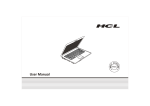
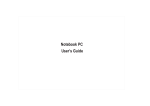
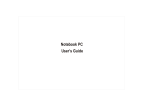
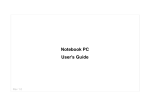

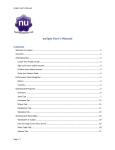
![600A01-manual-V1[1]](http://vs1.manualzilla.com/store/data/005768384_1-b36f8a87433f2b6e700f051b34ad2f22-150x150.png)
